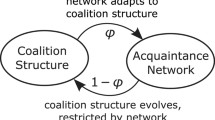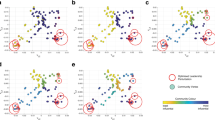Abstract
Many real-world networks exhibit community structures and non-trivial clustering associated with the occurrence of a considerable number of triangular subgraphs known as triadic motifs. Triads are a set of distinct triangles that do not share an edge with any other triangle in the network. Network motifs are subgraphs that occur significantly more often compared to random topologies. Two prominent examples, the feedforward loop and the feedback loop, occur in various real-world networks such as gene-regulatory networks, food webs or neuronal networks. However, as triangular connections are also prevalent in communication topologies of complex collective systems, it is worthwhile investigating the influence of triadic motifs on the collective decision-making dynamics. To this end, we generate networks called Triadic Graphs (TGs) exclusively from distinct triadic motifs. We then apply TGs as underlying topologies of systems with collective dynamics inspired from locust marching bands. We demonstrate that the motif type constituting the networks can have a paramount influence on group decision-making that cannot be explained solely in terms of the degree distribution. We find that, in contrast to the feedback loop, when the feedforward loop is the dominant subgraph, the resulting network is hierarchical and inhibits coherent behavior.
Access this chapter
Tax calculation will be finalised at checkout
Purchases are for personal use only
Similar content being viewed by others
References
Alon, U.: Network motifs: theory and experimental approaches. Nat. Rev. Genet. 8(6), 450–461 (2007)
Ariel, G., Ayali, A.: Locust collective motion and its modeling. PLoS Comput. Biol. 11(12), e1004522 (2015)
Buhl, J., Sumpter, D.J., Couzin, I.D., Hale, J.J., Despland, E., Miller, E.R., Simpson, S.J.: From disorder to order in marching locusts. Science 312(5778), 1402–1406 (2006)
Chen, L., Huepe, C., Gross, T.: Adaptive network models of collective decision making in swarming systems. Phys. Rev. E 94(2), 022415 (2016)
Colaiori, F., Castellano, C.: Consensus versus persistence of disagreement in opinion formation: the role of zealots. J. Stat. Mech.: Theory E 2016(3), 033401 (2016)
Czirók, A., Barabási, A.L., Vicsek, T.: Collective motion of self-propelled particles: Kinetic phase transition in one dimension. Phys. Rev. Lett. 82, 209–212 (1999)
Domínguez-García, V., Pigolotti, S., Muñoz, M.A.: Inherent directionality explains the lack of feedback loops in empirical networks. Sci. Rep. 4, 7497 (2014)
Huepe, C., Zschaler, G., Do, A.L., Gross, T.: Adaptive-network models of swarm dynamics. New J. Phys. 13(7), 073022 (2011)
Khaluf, Y., Hamann, H.: Modulating interaction times in an artificial society of robots. In: The 2018 Conference on Artificial Life (ALIFE), pp. 372–379. MIT Press (2019)
Khaluf, Y., Pinciroli, C., Valentini, G., Hamann, H.: The impact of agent density on scalability in collective systems: noise-induced versus majority-based bistability. Swarm Intell. 11(2), 155–179 (2017)
Khaluf, Y., Rausch, I., Simoens, P.: The impact of interaction models on the coherence of collective decision-making: a case study with simulated locusts. In: Dorigo, M., Birattari, M., Blum, C., Christensen, A.L., Reina, A., Trianni, V. (eds.) Swarm Intelligence: 11th International conference, ANTS 2018. LNCS, vol. 11172, pp. 252–263. Springer, Cham (2018)
Kirkman, T.P.: On a problem in combinations. Camb. Dublin Math. J 2(191–204), 1847 (1847)
Klaise, J., Johnson, S.: The origin of motif families in food webs. Sci. Rep. 7(1), 16197 (2017)
Mateo, D., Horsevad, N., Hassani, V., Chamanbaz, M., Bouffanais, R.: Optimal network topology for responsive collective behavior. Sci. Adv. 5(4), eaau0999 (2019)
Milo, R., Shen-Orr, S., Itzkovitz, S., Kashtan, N., Chklovskii, D., Alon, U.: Network motifs: simple building blocks of complex networks. Science 298(5594), 824–827 (2002)
Rausch, I., Reina, A., Simoens, P., Khaluf, Y.: Coherent collective behaviour emerging from decentralised balancing of social feedback and noise. Swarm Intell. 13(3), 321–345 (2019)
Shang, Y., Bouffanais, R.: Influence of the number of topologically interacting neighbors on swarm dynamics. Sci. Rep. 4, 4184 (2014)
Vicsek, T., Czirók, A., Ben-Jacob, E., Cohen, I., Shochet, O.: Novel type of phase transition in a system of self-driven particles. Phys. Rev. Lett. 75, 1226–1229 (1995)
Winkler, M., Reichardt, J.: Node-specific triad pattern mining for complex-network analysis. In: 2014 IEEE International Conference on Data Mining Workshop, pp. 605–612. IEEE Press, New York (2014)
Winkler, M., Reichardt, J.: Motifs in triadic random graphs based on steiner triple systems. Phys. Rev. E 88, 022805 (2013)
Yao, Y., Carretero-Paulet, L., Van de Peer, Y.: Using digital organisms to study the evolutionary consequences of whole genome duplication and polyploidy. PLOS One 14(7), 1–21 (2019)
Yates, C.A., Erban, R., Escudero, C., Couzin, I.D., Buhl, J., Kevrekidis, I.G., Maini, P.K., Sumpter, D.J.T.: Inherent noise can facilitate coherence in collective swarm motion. P. Natl. Acad. Sci. 106(14), 5464–5469 (2009)
Author information
Authors and Affiliations
Corresponding author
Editor information
Editors and Affiliations
Rights and permissions
Copyright information
© 2020 The Editor(s) (if applicable) and The Author(s), under exclusive license to Springer Nature Switzerland AG
About this paper
Cite this paper
Rausch, I., Khaluf, Y., Simoens, P. (2020). Collective Decision-Making on Triadic Graphs. In: Barbosa, H., Gomez-Gardenes, J., Gonçalves, B., Mangioni, G., Menezes, R., Oliveira, M. (eds) Complex Networks XI. Springer Proceedings in Complexity. Springer, Cham. https://doi.org/10.1007/978-3-030-40943-2_11
Download citation
DOI: https://doi.org/10.1007/978-3-030-40943-2_11
Published:
Publisher Name: Springer, Cham
Print ISBN: 978-3-030-40942-5
Online ISBN: 978-3-030-40943-2
eBook Packages: Physics and AstronomyPhysics and Astronomy (R0)




